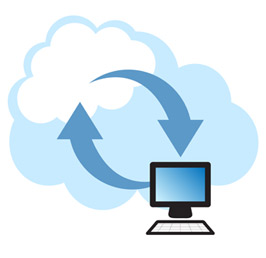What is the cloud?
As mysterious as it sounds, the cloud is a basic concept: information stored on computer servers “somewhere else”. That information can be anything – email, music, documents, calendars for example – and “somewhere else” can be anywhere off-site and remote to where you work with your information.
The cloud also refers to more advanced products often referred to as “software as a service” (SaaS). SaaS operates like software on your own computer, except you usually interact with these programs through your web browser and the information is stored on the service providers’ servers instead of your computer. Some examples of SaaS products include online accounting service Saasu and task and document management service Backpack.
Why is it called “the cloud”?
The term “cloud” began with diagrams used by network engineers when drawing maps of networks. Traditionally, external networks are drawn as a cloud to indicate that outside the network is one big cloud of data. It is not important how information travels through that cloud, only that it does indeed travel.
Why would I want to use the cloud in my business?
The cloud enables you to work wherever you are without worrying about where information is stored. It can make it easier for businesses to share documents between staff and work collaboratively without the resources of a large corporation or complicated internal network.
For example, you can use Google Docs to work on documents in a hotel room, share these documents with your colleagues back at the office for comments, and then make final changes while enjoying a coffee in the airport lounge.
Using some cloud services also allows you to let someone else take care of backing up files and maintaining hardware and security patches while you get on with running your business.
Getting used to the cloud, one step at a time
Adopting the cloud as part of your business strategy can be daunting for a small business. Cloud-based services require an substantial element of trust. How secure is my data? Will this service still be around in six months time? Do I have to commit to costly long-term contracts? Is it easy to get my information back out if I decide I want to use a different service? Can I still access my data if my internet connection is down?
These are legitimate questions and you should be comfortable with the answers before going further. However, if you are ready to give the cloud a test run, there are several applications that you can install immediately with any Digital Pacific business hosting plan. Using your own server space enables you trial working with cloud services while still retaining control of your information.
PHProjekt
PHProjekt is a free, web-based project management tool. It includes modules like calendars, file uploads, time cards, task lists and the ability to generate Gantt charts. You can manage work projects without expensive software licences for programs like Microsoft Project. As it is web-based, you and your staff have access to your projects anywhere you have internet access, whether that be at home, on the road or on-site with a client.
SugarCRM
SugarCRM is a popular Customer Relations Management (CRM) program that comes in free and paid versions. CRM is a system that helps you track your interactions with customers, personalise your communications and begin to understand your customers better. Installing a CRM system is not something to be done lightly, as using a CRM system effectively can require you to reassess your entire business workflow. However, if you think that you might be missing opportunities with your customers than a CRM can be a worthwhile investment of your time.
Is the cloud the answer to everything?
The cloud is not a turnkey solution that can be adapted to solve all problems. The questions raised earlier remain. These issues of security, off-line access and data portability will be deal-breakers for some. However, provided the services are the right fit for your organisation, the cloud can help your business become leaner and more flexible than ever before.








